What Are The Best Trolling Rigs For Lake Trout?
UPDATED 03 NOVEMBER 2023
by Robert Ceran
Trolling for lake trout is the most effective way to catch them when lake trout are dispersed over large areas, since you need to cover lots of water in order to find individual fish.
However, trolling for lakers is more complex than any other type of lake trout fishing, and requires having the right lake trout trolling setup in order to succeed with this method.
In this article we’ll cover the best lake trout trolling rigs, and will explain in detail how to tie them, when to use them, and what each of them is ideally suited for.
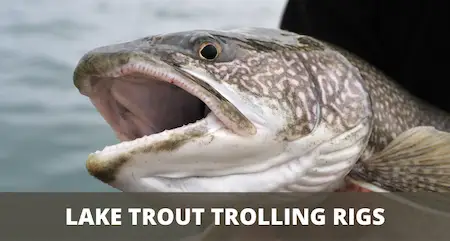
How to rig for trolling lake trout
The best trolling rigs for lake trout are:
- 3 way rig
- Spin-n-glo rig
- Cowbell rig
- Dodger rig
The great thing about these rigs is that you can mix and match them together in different combinations, and you can use them to troll for lake trout either with a downrigger or without.
Now let’s dive into the details, and take a closer look at each of these rigs for lake trout, so you can decide which one is best for your purposes.
3 way rig for lake trout
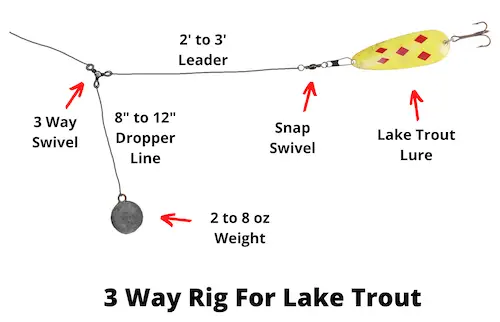
This is a great all around trolling rig for lake trout, and works especially well in spring, when lake trout are found in more shallow waters.
How to tie it: Start by tying your main line to a 3 way swivel. In my opinion, the best main line to use for this is 20 to 30 lb test braid. Next, tie a 1 foot dropper line to another eye of the 3 way swivel.
The dropper line should be weaker than your main line (in case your weight gets snagged on the bottom), and I like to use 10 to 15 lb test mono for this.
Tie a 2 to 8 oz weight at the end of your dropper line, or better yet, use a snap swivel that will allow you to change weights quickly.
Then tie a 2 to 3 foot leader to the third eye of the 3 way swivel, and tie a snap swivel at the end of it, that you can then attach to a lake trout lure.
The best leader is 15 to 20 lb test fluorocarbon, and again you should use a line that’s weaker than your main line, in case your lure gets snagged, in which case you won’t lose your whole rig.
When to use it: These are great rigs to use for near shore trolling in spring and autumn, when lake trout tend to push into shallow water of 20 or 30 feet depth.
You can adjust the depth at which your troll by changing the size of the weight, and by how much line you let out behind your boat.
How to use it: If possible, use a fish finder to scout the underwater terrain, and look for cruising lakers, as well as schools of bait fish that will tend to attract them.
When using a 3 way swivel rig for lake trout, always try to maintain bottom contact, as this is where most of the fish are concentrated.
A great strategy is to use planer boards with a spread of 6 to 8 trolling lines, which allows you to test different lures and trolling depths at the same time.
Spin-n-glo rig for lake trout
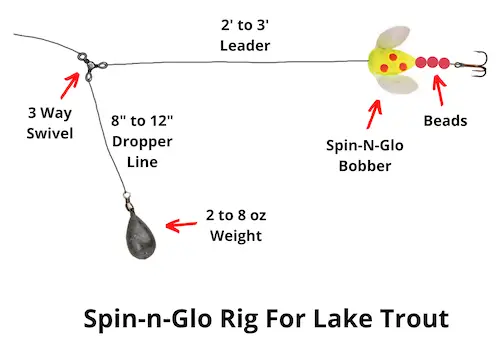
The spin-n-glo rig is an excellent bait presentation to use for lake trout trolling, and can be combined either with a 3 way rig, lead core trolling, or with a downrigger.
How to tie it: If you’re using the spin-n-glo setup with a 3 way rig, start by setting up the 3 way rig as discussed above, but instead of tying the leader to a snap swivel, thread a size 2 or 4 spin-n-glo bobber on to the end of your leader.
Next, thread on 2 to 4 plastic beads behind the spin-n-glo bobber, and then tie on a size 2 treble hook.
When to use it: This is a great trolling rig for lake trout that you can use during the whole open water season, and works well for both shallow and deep water trolling.
How to use it: If you’re using the spin-n-glo rig for shallow water lake trout, try to get your rig close to the bottom (which works up to about 30 feet of water depth with a 8 oz weight).
If you want to troll deeper than that, you can either use leadcore trolling, or resort to a downrigger for even great depth.
Cowbell trolling rig for lake trout
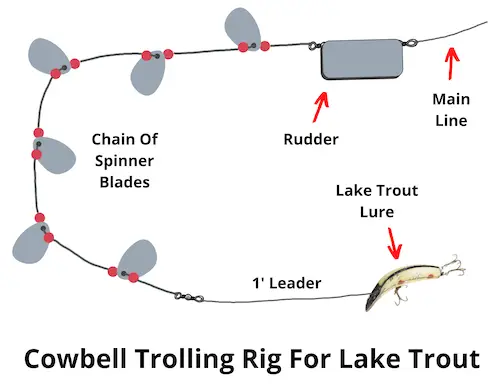
The cowbell trolling rig is a classical attractor setup that works like gangbusters for lake trout, and also makes a great salmon setup.
How to tie it: The best option is to get a ready made cowbell setup, which consists of a metal wire with 4 to 10 spinner blades attached to it.
On the bottom end of this setup is a snap swivel, which you should attach to a 1 foot leader with your lake trout lure tied at the end of it.
At the top end of the cowbell rig is a rudder, which helps to prevent the spinning of the blades from twisting your main line. Tie your main line to the swivel at the end of this.
When to use it: This is a great option for trolling on big lakes, where you need to cover a lot of ground in order to find lake trout.
The spinner blades of the cowbell trolling rig are able to rotate around the metal wire, since they are attached with a clevis, and this creates a lot of vibration and flashing in the water.
All of this commotion serves to attract lake trout in a wide radius around your boat, which helps to cover a lot of ground.
How to use it: This rig is most commonly used with a downrigger for trolling deep water lake trout in the summer. You can combine it with any of the common trolling lures, such as lake trout spoons, crankbaits, or spin-n-glo rigs.
Trolling dodgers for lake trout
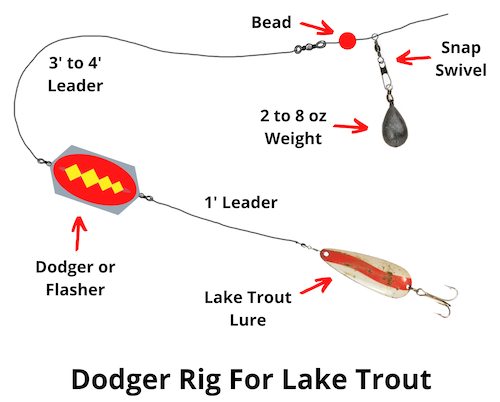
Dodgers are another type of attractor that works well for lake trout trolling, and can be readily used with a wide variety of lures and combined with different trolling setups.
How to tie it: In order to work properly, a dodger needs to have about 2 to 3 feet of leader line in front of it, as that allows it to wobble back and forth optimally in the water.
Start by threading your main line through the eye of a snap swivel, and then through a glass bead. Next, tie your main line to a barrel swivel, and then tie a 2 to 3 foot long monofilament leader to the other eye of the swivel.
Next, tie the dodger to the mono leader, and then tie a second leader to the other end of the dodger. The second leader should ideally be 10 to 15 lb test fluorocarbon, and about 1 foot long.
The end of the leader is then tied to a lure (or to a snap swivel which is in turn attached to a lure).
When to use it: The dodger trolling setup is another great option for trolling deep water lake trout with downriggers, but can also be used with a 3 way rig, or with lead core line.
Similar to the cowbell trolling rig, it creates a lot of commotion and flashes in the water, which helps to attract lakers from far and wide.
How to use it: Similar to the cowbell trolling rig, a dodger rig creates a lot of commotion and flashes of light in the water, which helps to attract lakers from far and wide.
Because of this it is ideal when you have to cover a lot of ground in search of deep water lake trout, and is best trolled with a downrigger.
Trolling for lake trout with downriggers
Downriggers are great for trolling for deep water lake trout during the hottest part of summer, and are ideal for targeting water depths over 60 feet, which are hard to reach with any other trolling methods.
Since lakers can regularly be found in water over 100 feet deep in July and August, downrigger trolling is one of the best ways to target them at this time.
Lake trout are strict coldwater fish, and need a temperature around 58 degrees in order to thrive. So when the surface water heats up in summer, they retreat to deeper and deeper water zones.
In order to find them at this time, it’s important to use a fish finder, since that will allow you to pinpoint the depth at which they are holding, and then set your downrigger to exactly the right depth.
Trolling for lake trout without downriggers
While downriggers are great for trolling for deep water lake trout, you can readily troll in depths up to 60 feet without using downriggers.
The best way to do this is with lead core line, which is designed to sink faster in the water, and you can even combine lead core line with a snap on weight, such as a dive bomb, to reach maximal depths.
Similar to trolling with downriggers, it’s best to use a fish finder to identify the depths at which lake trout are holding, since that will save you a lot of time testing different depth ranges.
Once you have found the right depth, you can then set all of your lines to the same depth to increase the chances of catching more lakers.
